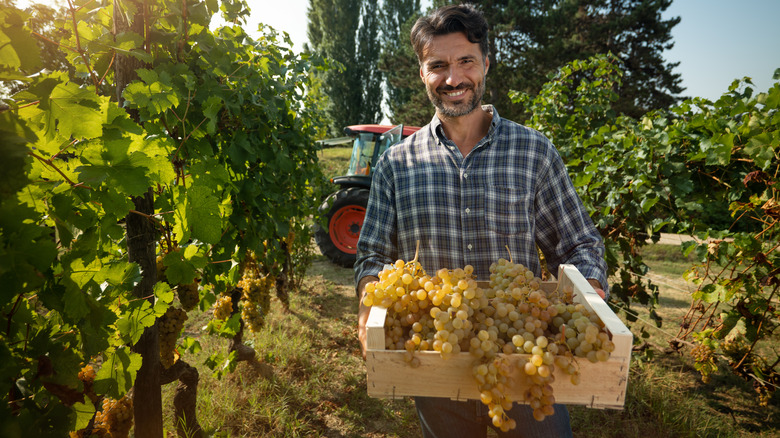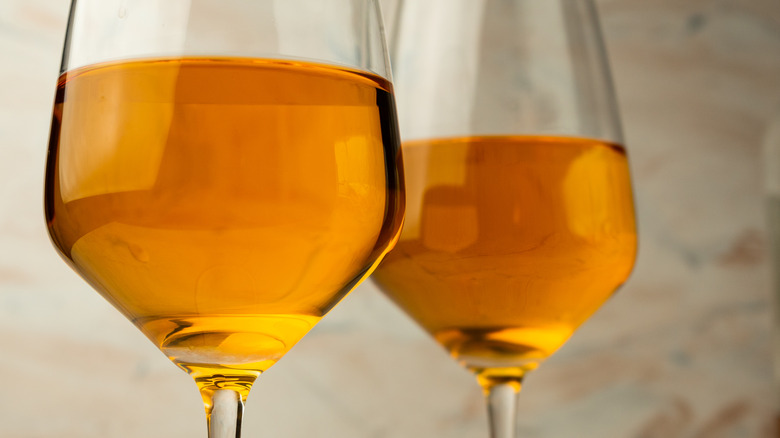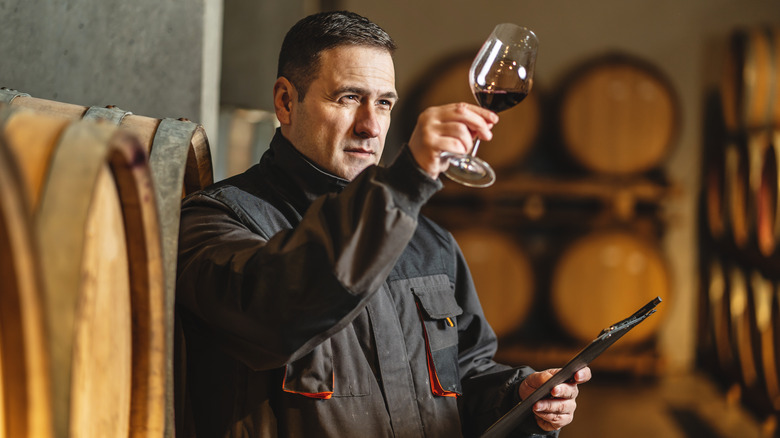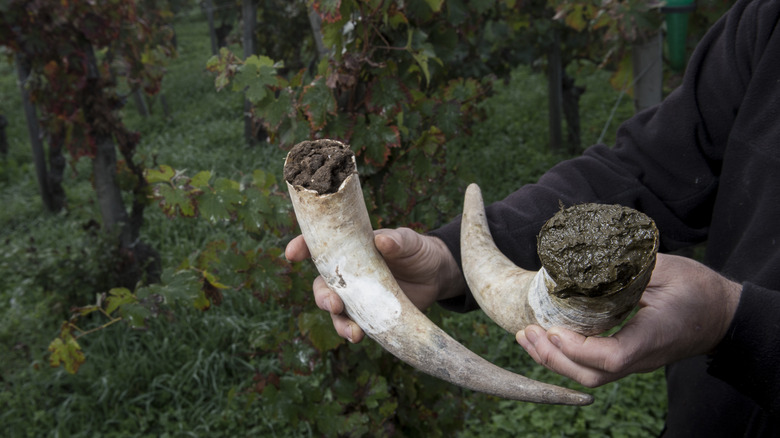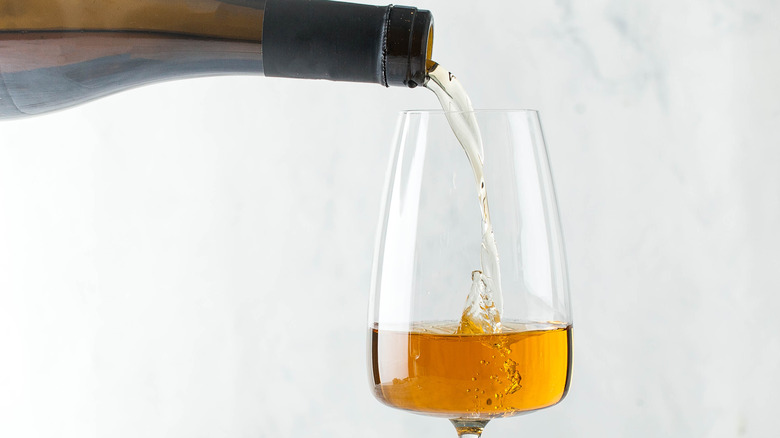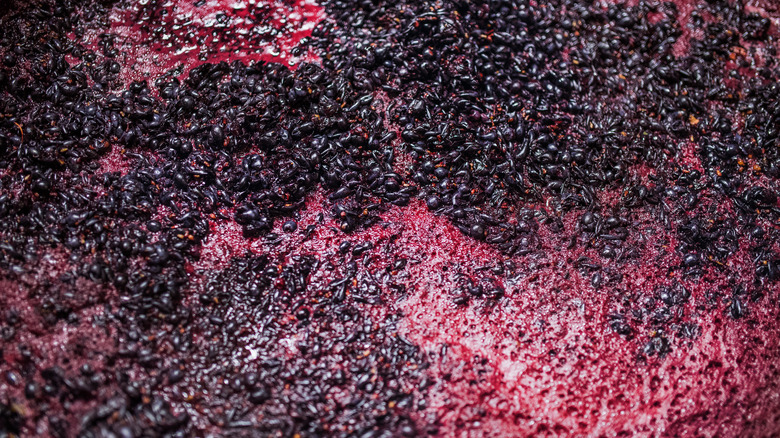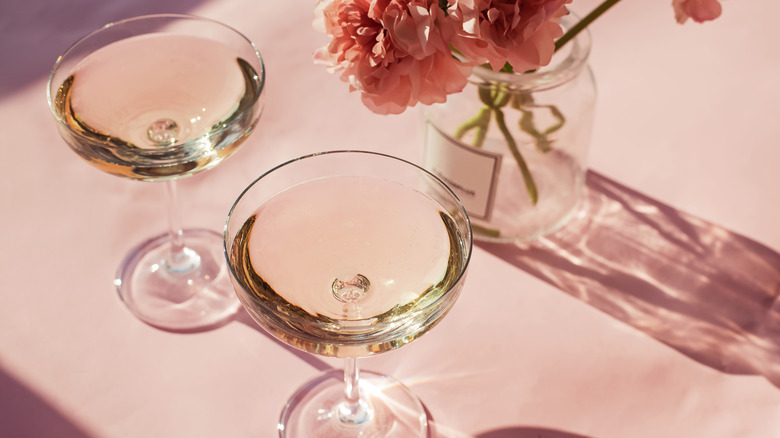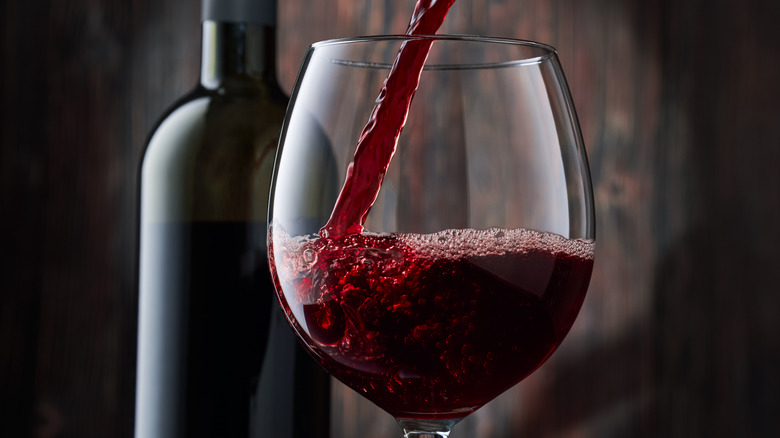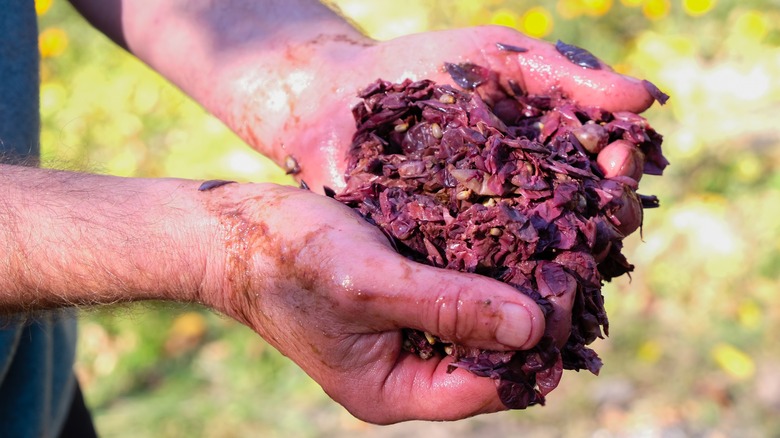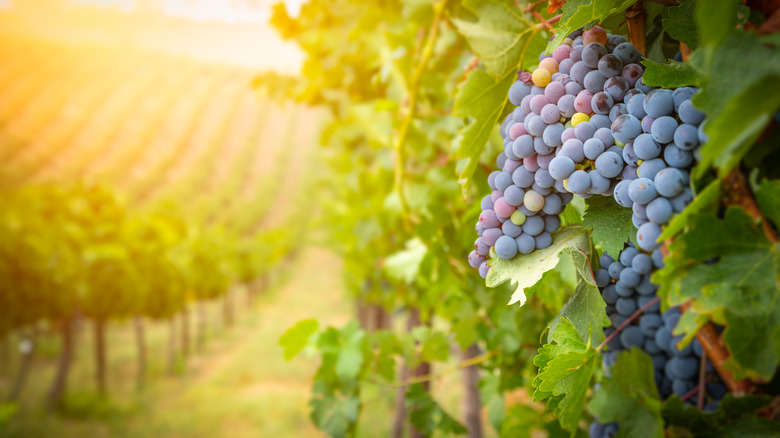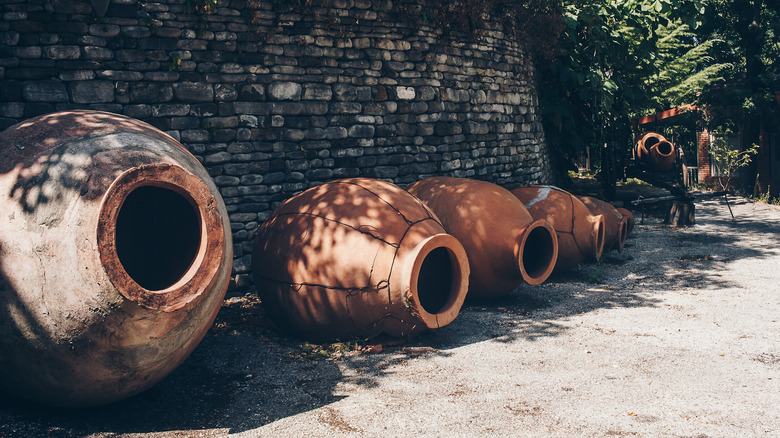13 Types Of Natural Wine Explained
The rise in popularity of natural wines has left consumers in a haze of ambiguous terms and wishy-washy regulations. For instance, what are the symbols gracing the back of the wines' labels? Rather than grabbing a bottle based on grape preference, the new consumer is buying wine based on the production method, moving away from the conventional, and opting for a unique experience. They're also shunning wines made with unnecessary chemicals and intervention for a cleaner drinking experience.
According to VinePair, the term "natural wine" currently has no legal definition, but worldwide independent organizations such as France's L'Association des Vins Naturels and Les Vins S.A.I.N.S, Italy's VinNatur, and Spain's Asociación de Productores de Vinos Naturales de España are working on adding clarity and designation to the category. There are numerous ways winemakers can make natural wine. Still, the ethos behind each one is to create a product with little addition in the vineyard and minimal intervention in the cellar.
We'll sort through some of the confusing terms and styles around natural wines, answering questions like: Is orange wine made with oranges? Why are wineries growing vines with a manure-filled cow horn buried next to them? Do natural wines contain sulfites — and do they result in fewer hangovers? Let's dive in.
Orange wine
Right off the bat, let's dispel any notions around the fruit used to produce orange wine — it is not made with oranges (although there are wineries in Florida that do make wine with oranges ... oh, Florida). Orange wine is similar to rosé in some ways. Rosé is made by allowing the juice to have contact with the skins of red wine grapes to give it that beautiful pink hue and impart texture and tannic structure. WineTraveler tells us that orange wine is the same, except it is made using white wine grapes. The result is an orange-hued wine with layers of complexity. This production method can impart notes of orange blossom, marmalade, and rooibos tea, among other intriguing nuances.
Orange wines have seen a considerable rise in popularity. However, they can be polarizing, especially when the skin contact is extended and the tannins are bold. Orange wines are made all over the world but are especially found in regions throughout Italy, Slovenia, Greece, Portugal, California, France, South Africa, and Australia, according to MasterClass.
Zero-zero wine
Let's talk a bit about sulfites. Many attribute sulfites to headaches and specifically look for wines that do not contain them (although according to Food and Wine, scientists have not found a link between sulfites and headaches). Thing is, all wines have sulfites — they occur naturally in the winemaking process. If you're looking to stay away from sulfites all the same, avoid conventional wines that add more sulfur to the wine during the winemaking process to stabilize it. Many large wineries strive for cookie-cutter wines, so consumers can expect the same outcome every time they drink them. A lot of sulfur is sometimes used to produce these results.
According to Sunset, "zero-zero" wine has no added sulfur. In fact, "zero-zero" means nothing is added, and nothing is taken away — it's a wine made in the most primitive way. There might be some vintage variation with this approach, but that is all part of the charm of authentic wines. There's room on the shelves for all kinds of wine, but zero-zero bottles are swiftly encroaching on the wine rack real estate.
Biodynamic wine
According to the Biodynamic Farming and Gardening Association, the official definition of biodynamic farming is "a spiritual-ethical-ecological approach to agriculture, gardens, food production and nutrition." The vineyard — along with animals, plants, trees, and soil — is thought of as one organism that contributes to the others. Rather than treat the earth and vines with herbicides and fertilizers, they use animals to fertilize it, per VinePair.
Austrian philosopher Rudolf Steiner started this agricultural movement in the early 1920s. He believed that farming symbiotically with nature should be done according to the lunar calendar. This method later became what is known as the biodynamic calendar. All farming practices, from pruning to harvesting, are broken into four types of days: root days, flower days, fruit days, and leaf days. Fruit days are meant for harvesting, leaf days for watering, and root days for pruning. On flower days, the vineyard is left alone.
So, what's with the cow horn? It may sound odd to pack a cow horn with manure, bury it in the ground, and then unearth it and spread it around the vineyard, but there's a method to the madness. This field preparation (also known as 500P) is done to structure the soil, strengthen photosynthesis, and enhance ripening, according to Biodynamie Services. Then, before being sprayed, it is stirred for an hour to reach its full potential, simulating the Earth's rotation. Prep 500 is just one of the compost and field preparations done on specific days according to the calendar.
Unfined/unfiltered
When a wine is made, it usually goes through a process of fining and filtering. As Terravenos explains, juice from crushed grapes contains tiny particulates of matter that can make it look cloudy. The method of removing the particulates involves gravity or chemical intervention. While all of the agents used to fine a wine are removed in the process, some feel the step unnecessary and a possible detriment to making "real wine." The agents used in fining might surprise you — gelatin, isinglass (a fancy name for fish bladders!), egg whites, casein, skim milk, bentonite clay, carbon, and polyvinylpolypyrrolidone (PVPP), per The Australian Wine Research Institute.
When filtering a wine, it is precisely what it sounds like — the juice goes through a filter. However, some natural winemakers feel it dilutes the depth of character. The final phase, called microfiltration, removes all particles and organisms down to .45µm in order to achieve a crystalline wine. Unfortunately, this removes most of the yeasts used in the winemaking process. But, according to MYSA, keeping the living agents intact allows the wine to keep evolving in the bottle and to age for extended periods.
Low intervention
Low intervention is pretty much the baseline for natural wine. Winemakers that make low-intervention wines aim not to meddle with the cellar but will if necessary. This means no added sulfur, the use of native (ambient) yeasts instead of store-bought, and, in some cases, avoiding temperature control. The great thing about this style of wine is that winemakers strive for the cleanest, most natural expression, but are not dogmatic about it. Winemaker and owner of Swick Wines, Joe Swick, told Wine-Searcher, "I'm not a fan of having to dump wines down the drain. If it means 10-20 ppm total SO2 added to a wine, I will do it. I prefer wine that tastes like wine, not kombucha."
But it's not just the cellar that is hands-off. The growing vines should not be treated chemically but with thoughtful pruning, canopy management, and herbal treatments. Hands-off might sound like a lazy way to grow and make wine, but in some ways, it is more labor-intensive. Homeopathic treatments can be weak, so they must be applied more frequently than chemical treatments. Plus, there are higher risks for disease and rot, so frequent and careful pruning to allow air in is imperative.
Glou-Glou
Glou-glou wines are incredibly chuggable, hence the name, which is meant to mimic the sounds of someone gulping down booze (as in, "glug glug"). The essence of a glou-glou wine is that it's super easy to drink, doesn't require much thought, and is usually light and fresh without the tertiary character that comes from manipulation in the cellar and aging. Many are lower in alcohol, too. Many red glou-glou wines are best served with a sight chill to drive home the crispness. Coly Den Haan, the owner of Vinovore Wine Shop in Los Angeles, explained the style to Refinery29, saying, "most natural winemakers lean toward lighter, fresher style wines with juicy acidity and lower alcohol, which makes them more glug-worthy."
The style has gained such popularity that comedian/winemaker Eric Wareheim named one of his Las Jaras wines "Glou Glou." He says it was created to be the perfect wine for circle foods (pizza and burgers). According to MYSA, natural wine cheerleader and sommelier Lee Campbell named her natural wine tasting event in Brooklyn "The Big Glou." Happy chugging!
Carbonic maceration
How do natural winemakers achieve light-bodied, low tannin, and fruit-forward red wines? Carbonic maceration, of course! What the heck is carbonic maceration, you ask? Well, if you've ever enjoyed a red wine from the Beaujolais wine region in France, then you have probably encountered a carbonic macerated wine.
In short, carbonic maceration is a way of fermenting wine grapes intracellularly — meaning, they ferment inside themselves. According to MasterClass, whole clusters of grapes are placed in a sealed, carbon dioxide-filled tank to start fermentation within the grapes. In order to do this, the grapes must be hand-harvested rather than going through a de-stemmer.
Once the carbon dioxide replaces the existing oxygen, the environment becomes anaerobic. This causes the grapes to release enzymes that begin the fermentation on the inside. More carbon dioxide is released during fermentation, causing the grape skins to burst when the juice inside reaches about 2% alcohol. The skins and stems are removed and yeast is added. Once the yeast eats all the natural sugars and turns them into alcohol, you are left with a red wine that bursts with fresh aromas and flavors.
Pét-nat
Short for pétillant-naturel, pét-nats have taken the natural wine world by storm. Club Oenologique explains that pét-nats are sparkling wines that only go through one fermentation in a single process. While thought of as more uncomplicated when compared to Champagnes and cavas, Champagne took a few pages from pét-nat's playbook. Pét-nats, or "méthode ancestral" wine, originated in Limoux in southwestern France in the 16th century, making it the original way to produce sparkling wine.
Pét-nats are meant to be consumed while they're young and exude lots of crisp fruit and racy acidity. They are typically lighter and lower in alcohol than their counterparts. There's also a wildness that can't be found in other sparklers — a bit rustic and a bit savory. Some are slightly off-dry, so there might be a touch of sweetness. Tip: If you want a bone-dry pét-nat, put it in a sunny window — the sunlight will speed up the fermentation, meaning the yeasts will liven up and eat away the rest of the sugar.
Bretty
Possibly the most polarizing trait of natural wines is brett. Short for "brettanomyces," brett is an organism that can mess with or transform a wine's aromas and flavors. According to Wine Enthusiast, brett produces volatile phenols, including 4-ethylphenol and 4-ethylguaiacol. What does this mean? Well, these compounds can impart unplanned notes onto a wine. They can range from funky (barnyard, bandage, bacon, and heavy metal) to floral (roses, jasmine, and musk). Some of these notes probably sound unappealing, but brett backers claim they add complexity (as long as it doesn't overpower the wine's innate traits). Chris Howell, winegrower at Cain Vineyard & Winery in California's Spring Mountain District, waxed poetic about brett to Wine Enthusiast, saying, "Our experience of wine is sensual and sensuous. Smell alone can evoke memories and emotion. Perfumers understand that, as with color, no particular odor is intrinsically good or bad. It's all a matter of context and experience."
Many feel differently, and say brett is unpredictable and can spoil what a winemaker worked hard to create. William Allen, the winemaker at Two Shepherds in Windsor, California, says, "it's a negative bacteria, and you can't dial it up and say, 'hey, I just want a barnyard brand of brettanomyces.' Once it's in the bottle, it can evolve and is therefore uncontrollable in terms of what it does to aromatics." It's kind of a "you get what you get, and you don't get upset" type of situation.
Vegan wine
What do you mean wine isn't vegan? It's true. The winemaking process often includes the use of animal parts and byproducts. The agents used in fining might include gelatin, fish bladders, egg whites, and more. To cater to vegetarians and vegans, many wineries began using vegan-friendly products to filter and fine their wines. PETA states that many common fining agents are animal-friendly, such as carbon, bentonite clay, limestone, kaolin clay, plant casein, silica gel, and vegetable plaques.
According to The Vintner Project, Frances Gonzales started the first company to solely import vegan wines through Despacito Distributors and set up an online shop aptly named Vegan Wines. She has seen a massive increase in demand for vegan wines since 2017, saying, "when I first started to approach winemakers in California, I remember people being offended (vegans can have a love or hate impact on people), but now many are using the term vegan-friendly on their wine bottles. As a result, winemakers now approach me, making my work life easier. The vegan wine demand is there, and it will keep growing."
Piquette wine
Looking for a refreshing, low AVB summer cooler? Look to piquette — it's known in the wine world as a natural wine cooler. However, when Lenn Thompson wrote about it in 2019 for SevenFifty Daily, not many people had heard of it. Since then, it has gained momentum. Piquette is a repurposed product made by adding water to grape must (or pomace) and fermenting what's left of the sugars. Jess Miller, a farmer and winemaker at Little Crow Vineyards in Oregon's Willamette Valley, told SevenFifty Daily, "I like to compare it to re-steeping tea — like in a French press." The result is a light and thirst-quenching beverage with a slight spritz, similar to a wine spritzer.
You can't talk about piquette without mentioning Wild Arc Farms in the Hudson Valley region of New York. Owner Todd Cavallo is said to have introduced this traditional beverage to North America. The method originated in France — the name is derived from the French word for "prickle" but was considered a low-class beverage served to enslaved people and swiftly went out of style. However, according to SevenFiftyDaily, Cavallo started making it as a serious product with 125 cases in 2017, and by 2019, he was making around 400.
Organic wine
You might think that all organic wines are natural, but that's not always the case. Indeed, the ethos of natural wine aligns with making a product as organically as possible, so the two styles overlap on a Venn diagram. However, Wine Folly states that "organic doesn't imply that the wine doesn't have additives," so many organically-labeled wines will still contain egg whites and animal enzymes (like rennet in cheese). Wine Investment states that in order to achieve organic certification status, no chemical fertilizers or pesticides are to be used on the grapes grown for that wine. From there, the method of production is varied. Natural wineries, of course, will harvest by hand and use as little manipulation in the cellar as possible.
Certification is different worldwide, but the basic gist is that synthetic pesticides and herbicides are not allowed to meet organic certification qualifications. In addition, the price of organic certification is a deterrent for many — a one-off application fee and subsequent renewal and inspection fees can add up, so some organic practicing vineyards forgo certification.
Amphora wine
One of the oldest ways to make wine is in amphora. Originating in the country of Georgia over 8,000 years ago, this style has come to the fore over the last decade. Amphora is a terracotta vessel, locally called Qvevri, used to store wine. When a wine is made this way, the amphora allows for slow oxidation, giving it an orange or amber hue. Amphora wines also undergo extended skin contact (much like the method of making orange wines), doubling the concentration of color richness — per The Manual.
You can expect this style of wine to be heavily concentrated and brimming with tannic structure. Amphora wines are also quite textural given the access to lees (dead yeast cells that sit at the bottom of the vessel giving wines a full mouth-feel and heightened flavors) thanks to the curved nature of the pots. This may not sound appealing, but wine aficionados sing its praises. Winemakers worldwide have fallen for the style and added amphora to their cellars in addition to barrels and stainless steel tanks.
